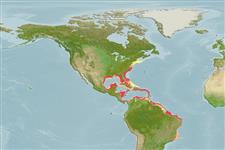>
Scombriformes (Mackerels) >
Scombridae (Mackerels, tunas, bonitos) > Scombrinae
Etymology: Scomberomorus: Latin, scomber = mackerel + Greek, moros = silly, stupid (Ref. 45335).
More on author: Cuvier.
Environment: milieu / climate zone / depth range / distribution range
Ecologia
marino; oceanodromo (Ref. 51243); distribuzione batimetrica 5 - 140 m (Ref. 36484), usually 5 - 15 m (Ref. 40849). Tropical; 44°N - 22°S, 98°W - 34°W (Ref. 54879)
Western Atlantic: Canada (Ref. 5951) to Massachusetts, USA to São Paulo, Brazil. Eastern Central Atlantic: St. Paul's Rocks (Ref. 13121).
Length at first maturity / Size / Peso / Age
Maturity: Lm 64.8, range 45 - 114 cm
Max length : 184 cm TL maschio/sesso non determinato; (Ref. 9710); common length : 70.0 cm FL maschio/sesso non determinato; (Ref. 168); peso massimo pubblicato: 45.0 kg (Ref. 168); Età massima riportata: 26 anni (Ref. 128047)
Spine dorsali (totale) : 12 - 18; Raggi dorsali molli (totale) : 15 - 18; Spine anali: 0; Raggi anali molli: 16 - 20; Vertebre: 41 - 43. Interpelvic process small and bifid. Swim bladder absent. Lateral line abruptly curving downward below second dorsal fin. Intestine with 2 folds and 3 limbs. Adults have no black area on the anterior part of the first dorsal fin. Juveniles with bronze spots in 5 or 6 irregular rows. Body entirely covered with scales.
Often found in outer reef areas. Larvae are encountered in surface waters of 26.3° to 31°C and 26.9 to 35 ppt. Feeds primarily on fishes with smaller quantities of penaeid shrimps and squids. Large schools have been found to migrate over considerable distances along the Atlantic US coast, water temperature permitting. It is an important species for recreational, commercial, and artisanal fisheries throughout its range. Most of the catch is processed into steaks or sold fresh, or sometimes canned and salted. Also prepared smoked and frozen (Ref. 9987). Potentially ciguatoxic in certain areas (Ref. 9710). Sometimes called "Kingfish" (Ref. 13442).
Collette, B.B. and C.E. Nauen, 1983. FAO Species Catalogue. Vol. 2. Scombrids of the world. An annotated and illustrated catalogue of tunas, mackerels, bonitos and related species known to date. Rome: FAO. FAO Fish. Synop. 125(2):137 p. (Ref. 168)
IUCN Red List Status (Ref. 130435)
Threat to humans
Reports of ciguatera poisoning (Ref. 9710)
Human uses
Pesca: commerciale; Pesce da pesca sportiva: si
Strumenti
Special reports
Download XML
Fonti Internet
Estimates based on models
Preferred temperature (Ref.
123201): 23.5 - 28.1, mean 27.2 °C (based on 1034 cells).
Phylogenetic diversity index (Ref.
82804): PD
50 = 0.5000 [Uniqueness, from 0.5 = low to 2.0 = high].
Bayesian length-weight: a=0.00912 (0.00713 - 0.01166), b=3.02 (2.98 - 3.06), in cm total length, based on LWR estimates for this species (Ref.
93245).
Trophic level (Ref.
69278): 4.4 ±0.3 se; based on diet studies.
Generation time: 6.1 (4.5 - 7.3) years. Estimated as median ln(3)/K based on 31
growth studies.
Resilienza (Ref.
120179): Medio, tempo minimo di raddoppiamento della popolazione 1.4 - 4.4 anni (K=0.07-0.15; tm=2; tmax=14; Fec=70,000).
Prior r = 0.47, 95% CL = 0.31 - 0.71, Based on 3 full stock assessments.
Fishing Vulnerability (Ref.
59153): Moderate to high vulnerability (48 of 100).
Climate Vulnerability (Ref.
125649): Moderate to high vulnerability (55 of 100).
Nutrients (Ref.
124155): Calcium = 20.3 [9.2, 71.9] mg/100g; Iron = 0.707 [0.314, 1.640] mg/100g; Protein = 20.6 [19.4, 21.9] %; Omega3 = 0.238 [0.149, 0.393] g/100g; Selenium = 74.7 [27.2, 232.8] μg/100g; VitaminA = 17.7 [4.4, 77.8] μg/100g; Zinc = 0.568 [0.380, 0.903] mg/100g (wet weight); based on
nutrient studies.
